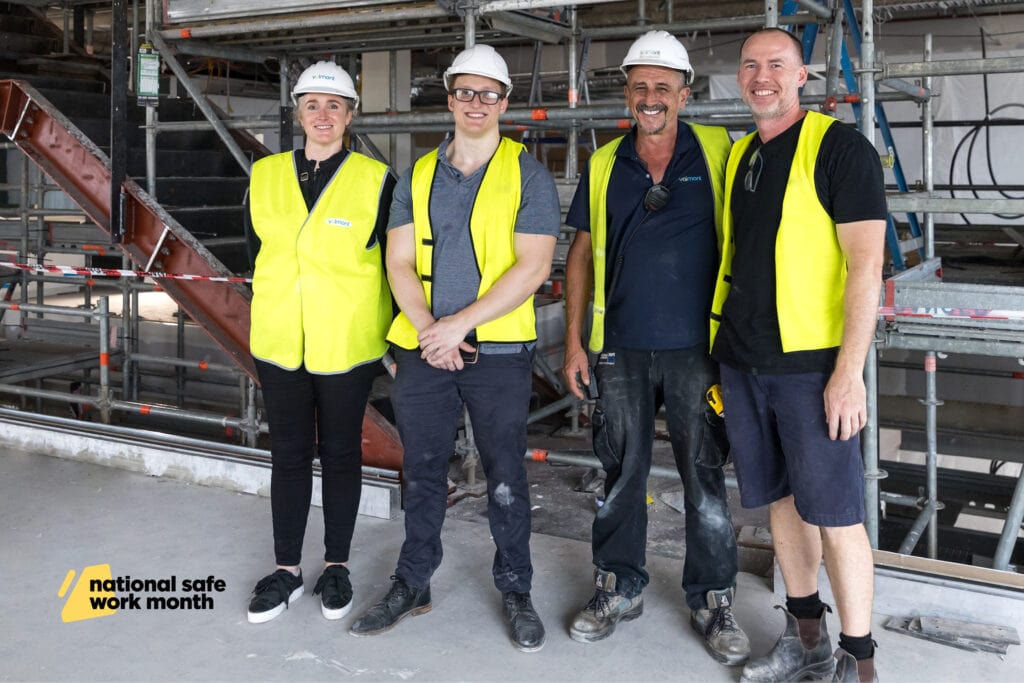October is National Safe Work month, and to help drive greater awareness and action, our HSEQ Leader, Jasmin Shelley, is publishing articles that align with Work Safe month’s weekly themes. Jasmin is also connecting with onsite team members to hear their perspectives. Jasmin joined Valmont early in 2023. She is currently studying Neuropsychology and has a passion for psychosocial health.
This week, the work safe theme is Working Together to Protect Workers’ Mental Health. Here, Jasmin outlines the importance of protecting physical health, how to identify psychosocial hazards and manage the associated risks to protects workers, and provides some ideas on organising something at work to acknowledge World Mental Health Day on 10 October.
___
In today’s fast-paced world, filled with external pressures from global events to constant online updates, managing stress becomes crucial. One significant area where we can apply influence is workplace stress. A positive work environment enhances our well-being, providing purpose, routine, mental stimulation, and a boost in self-worth. However, negative experiences can compound personal worries.
Safeguarding mental health at work requires a joint effort from both employers and employees.
For employers:
- Create a welcoming environment for everyone, one that promotes an inclusive workplace and celebrates diversity.
- Advocate a balanced work/life approach: if employees consistently work overtime, it’s a sign to re-evaluate workload and support.
- Set clear job expectations: uncertainty can cause stress, so ensure leadership is approachable and effective.
- No workplace is perfect, but recognising shortcomings and working towards a balanced environment is essential. Recognition: acknowledge and reward employee achievements
For employees
- Exercise regularly: even a 30-minute walk can enhance both physical and mental well-being.
- Prioritise self-care: whether it’s a spa session or a weekend football game, find what rejuvenates you.
- Open up: share feelings with loved ones, friends, or colleagues. If needed, seek professional guidance from a GP, EAP Counselling Service, or mental health helpline.
- Practice your communication skills: avoid bottling up emotions – effective communication is therapeutic!
- Unplug when necessary: In our digital age, it’s vital to set boundaries. Recognise burnout signs and ensure you have time to disconnect.
- Goal setting: establish clear and measurable objectives. This not only guides your progress but also fosters a sense of achievement and boosts self-worth.
It’s natural to experience work-related stress and job-related concerns. Yet, with the right strategies supported by both employer and employee, achieving work-life balance is within reach.
Let’s hear from Ethan Gillett, Project Coordinator, Brisbane.

So Ethan, what kinds of psychosocial hazards do you see in your workplace?
Job demands leading to fatigue. For example, ensuring projects are being delivered within budget and on time can at times cause heightened levels of stress and increased work hours resulting in fatigue. Prolonged periods of this trend can in turn cause burnout.
I believe all these are manageable with good organisational systems and processes.
What do you think as an organisation we can all do to reduce the stigma and protect our workers mental health in the workplace?
Build team spirit and open communication – having all colleagues and sub-contractors adopting a ‘team’ attitude is integral. With this mantra, each team member feels supported and comfortable to approach others and tackle problems and tasks together.
Much as a team member would in a sports team, each player wants to perform and give 100% every game, always looking to improve their skills, and most importantly assist others to perform their best for an optimal team result. This ‘all for one and one for all’ attitude boosts morale and in turn the mental health of employees in the workplace.
What can we do to improve the way we work with our sub-contractors to increase their knowledge and awareness of mental health?
We can form partnerships, introduce site signage or arrange functions and workshops with organisations like Mates in Construction and Livin (It Aint Weak to Speak).
In my opinion the most engaging mental health awareness initiative is the Push-Up Challenge which I completed in June with a few mates. It consisted of an allocated number of push-ups to complete everyday through the Push-Up Challenge app. At the end of the month, each participant will have completed 3,144 push-ups. In terms of awareness, each number of push-ups for the day has a statistic/fact relating to either mental health or suicide. For example, Australia lost 3,144 people to suicide in 2021 hence the 3,144 total push-ups. Throughout the month my team raised $805 for Lifeline which was very rewarding.
In terms of further subcontractor engagement regarding this topic, I believe incorporating mental health discussions to some toolbox talks and pre starts could be a good place to start increasing knowledge and awareness.
Weekly topics in full
Here’s a little more detail on the next two topics, as part of Safe Work Month, including links out to the Safe Work Australia website:
Week 3 (16-22 October) – Working together to support all workers
All workers have the right to be safe at work.
Factors known to affect workers’ WHS vulnerability include being younger, working alone, being from a culturally and linguistically diverse background or working in a more complex contractual chain (e.g. labour hire).
In week 3 of National Safe Work Month, learn what PCBUs must do to manage risks to the health and safety of vulnerable workers.
Week 4 (23-31 October) – Working together to ensure a safe and healthy workplace
Workers continue to be injured or made unwell by work. Let’s keep workers safe and healthy by ensuring WHS is core to how we do business in Australia.
During the final week of National Safe Work Month, learn about the future of work health and safety, including changing patterns and ways of working as well as the emergence of new forms of work.
